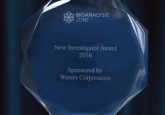2017 New Investigator Award: Szabolcs Szarka

 Szabolcs Szarka (LGC, UK)
Szabolcs Szarka (LGC, UK)
What made you chose a career in bioanalysis?
As an undergraduate student in Pharmacy I spent a summer internship within a pharmacokinetics bioanalytical laboratory at a pharmaceutical company, where I was exposed to the techniques and workflows used to support pharmacokinetic studies. I recognized the importance of bioanalysis in the drug development process and I was very impressed by the technical side. This early experience remained a key driving force in pushing me towards an eventual career in bioanalytical research and a passion for chromatography coupled to mass spectrometry.
Describe the main highlights of your bioanalytical work?
My scientific interest focuses mainly on the bioanalytical applications of chromatography and mass spectrometry techniques. As a PhD student I developed GC-MS assays for volatile and semi-volatile analytes extracted from plants and studied the feasibility of solid-phase microextraction (SPME) sampling techniques.
Throughout my postdoctoral training I developed multiple LC-MS assays supporting pre-clinical drug discovery and development. I gained hands-on experience with various GC and LC-MS platforms and became adept at troubleshooting both the assays and instruments. I had a chance to explore the potential of unconventional ionization techniques such as chip-based nanoLC and direct analysis in real time (DART) techniques. I also performed proteomics studies using a variety of approaches including bottom-up, non-targeted shotgun protein identification and label-free relative quantification.
In my current position I focus on absolute quantification of peptides and proteins, such as biomarkers as well as therapeutic proteins. The assays developed are used to support pre-clinical and clinical drug development projects.
I have presented our results at conferences and contributed to 27 papers in peer-reviewed scientific journals (7 first-author).How has your work impacted your laboratory, the bioanalytical field and beyond?
As a postdoctoral research fellow I have developed methods, which supported high profile early stage drug discovery projects in our lab. Additionally I have developed analytical assays for the screening of illicit substances in horse samples collected at walking-horse shows (2012‒2013) and at the World Grand Championship (2012) in Shelbyville, TN. My group published one such assay which helped in identifying forbidden practices with the aim of ultimately stopping animal abuse.
In my current position at LGC I develop and validate quantitative large molecule assays. The generated data is used in decision making through various stages of the drug development process. One of our current focuses is on the identification, evaluation and implementation of new techniques and technologies offering the ability to improve existing large molecule workflows, in terms of sensitivity, throughput and efficiency.
Describe the most difficult challenge you have encountered in your scientific career and how you overcame it?
My most recent career move has seen move into the world of protein/peptide bioanalysis. Coming from a small molecule background, this transition has required a change of mindset due to the different workflows and specific sample preparation techniques, such as immunoaffinity clean up procedures etc. It has been a challenging and very exciting transition period. I have received unprecedented help and support from fellow researchers and mentors in my organization and my enthusiasm and passion towards new techniques has helped to achieve confidence in this area.
Describe your role in bioanalytical communities/groups?
I am member of the technical specialist and the mass spectrometry specialist groups at LGC. We have a particular focus on training junior staff and also on keeping our working knowledge up-to-date with the ever developing bioanalytical science. We organize meetings, where I have presented assay troubleshooting case studies and have summarized progress of our development work to fellow researchers.
I believe that information or knowledge transfer is the main drive of development in science therefore presenting and publishing research findings is of great importance for me.
List up to five of your publications in the field of bioanalysis:
1 Zant JC, Kim T, Prokai L, Szarka S, McNally J, McKenna JT, Shukla C, Yang C, Kalinchuk AV, McCarley RW, Brown RE, Basheer R, “Cholinergic neurons in the basal forebrain promote wakefulness by actions on neighboring non-cholinergic neurons: An opto-dialysis study” J. Neurosci. 2016, 36:2057-2067.
2 Szarka S, Prokai L, “Chip-based nanoelectrospray ionization with Fourier transform mass spectrometric detection to screen for local anesthetics intended to mask limb sore in walking horses” J. Mass Spectrom. 2015, 50:533-537.
3 Szarka S, Prokai-Tatrai K, Prokai L, “Application of screening experimental designs to assess chromatographic isotope effect upon isotope-coded derivatization for quantitative liquid chromatography-mass spectrometry” Anal. Chem. 2014, 86:7033-7040.
4 Szarka S, Nguyen V, Prokai L, Prokai-Tatrai K, “Separation of dansylated 17β-estradiol, 17α-estradiol, and estrone on a single HPLC column for simultaneous quantitation by LC-MS/MS” Anal. Bioanal. Chem. 2013, 405:3399-3406.
5 Prokai L, Szarka S, Wang X, Prokai-Tatrai K, “Capture of the volatile carbonyl metabolite of flecainide on 2,4-dinitrophenylhydrazine cartridge for quantitation by stable-isotope dilution mass spectrometry coupled with chromatography” J. Chromatogr. A 2012, 1232:281-287.
Find out more about this year’s New Investigator Award, the judging panel and the rest of our nominees.




